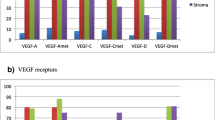Relationships between the incidence of metastatic spread and microvessel density, expression of proto-oncogene products, or expression of resistance-related proteins were investigated in human ovarian carcinomas by immunohistochemistry. Ovarian carcinomas with a high microvessel density showed a significantly increased formation of metastases (P=0.005). Tumors with positive immunoreactivity of c-jun and c-myc products had a higher metastatic spread; however, these results were not statistically significant. A marginally significant correlation existed between the expression of erbB1 (EGFR) and metastatic spread (P=0.05). No significant relationship was found between the expression of the resistance-related proteins P-glycoprotein or glutathione S-transferase-π and the incidence of metastases. Furthermore, no correlation was detected between expression of the heat shock protein 70 and the occurrence of metastases.
Similar content being viewed by others
References
Poste G and Fidler, IJ, 1980, The pathogenesis of cancer metastasis. Nature, 283, 139–46.
Nicolson GL, 1984, Tumor progression, oncogenes and the evolution of metastatic phenotypic diversity. Clin Exp Metastasis, 2, 85–105.
Volm M, Drings P, Wodrich W and van Kaick G, 1993, Expression of onco-proteins in primary human non-small cell lung cancer and incidence of metastases. Clin Exp Metastasis, 11, 325–9.
Weidner N, Corroll PR, Flax J, Blumenfeld W and Folkman J, 1993, Tumor angiogenesis correlates with metastasis in invasive prostate carcinoma. Am J Pathol, 143, 401–9.
Volm M, Bak M, Efferth T, Lathan B and Mattern J, 1988, Immunocytochemical detection of a resistance-associated glycoprotein in tissue culture cells, ascites tumors and human tumor xenografts by Mab 265/F4. Anticancer Res, 8, 531–6.
Volm M, Kästel M, Mattern J and Efferth T, 1993, Expression of resistance factors (P-glycoprotein, glutathione S-transferase-π and topoisomerase II) and their interrelationship to proto-oncogene products in renal cell carcinoma. Cancer, 71, 3981–7.
Weidner N, 1995, Intratumor microvessel density as a prognostic factor in cancer. Am J Pathol, 147, 9–19.
Bosari S, Lee AK, DeLellis RA, Wiley BD, Heatley GJ and Silverman ML, 1992, Microvessel quantitation and prognosis in invasive breast carcinoma. Hum Pathol, 23, 755–61.
Weidner N, Semple JB, Welch WR and Folkman J, 1991, Tumor angiogenesis and metastasis. Correlation in invasive breast carcinoma. New Engl J Med, 324, 1–8.
Maeda K, Chung YS, Takatsuka S, et al. 1995, Tumor angiogenesis as a predictor of recurrence in gastric carcinoma. J Clin Oncol, 13, 477–81.
Olivarez D, Ulbright T, DeRiese W, et al. 1994, Neovascularization in clinical stage I testicular germ cell tumor: prediction of metastatic disease. Cancer Res, 54, 2800–2.
Welch DR, Bisi JE, Miller BE, et al. 1991, Characterization of a highly invasive and spontaneously metastatic human malignant melanoma cell line. Int J Cancer, 47, 227–37.
Sato K, Miyahara M, Saito T and Kobayashi M, 1994, C-myc mRNA overexpression is associated with lymph node metastasis in colorectal cancer. Eur J Cancer, 30, 1113–17.
Fontanini G, Vignati S, Bigini D, et al. 1995, Epidermal growth factor (EGFR) expression in non-small cell lung carcinomas correlates with metastatic involvement of hilar and mediastinal lymph nodes in the squamous subtype. Eur J Cancer, 31, 178–83.
Fujino S, Enokibori T, Katsura A, et al. 1994, Relationship between epidermal growth factor receptor expression and various prognostic factors in human non-small cell lung cancer. Lung Cancer — Japan, 34, 89–94.
Diez M, Maestro ML, Torres A, et al. 1994, Epidermal growth factor receptor in non-small cell cancer of the lung. Arch Broncopneumol, 30, 282–6.
Khalifa MA, Manuel RS, Haraway SD, Walker J and Min KW, 1994, Expression of EGFR, HER-2/neu, p53, and PCNA in endometrioid, serous papillary, and clear cell endometrial adenocarcinomas. Gynecol Oncol, 53, 84–92.
Castellani R, Visscher DW, Wykes S, Sarkar FH and Crissman JD, 1994, Interaction of transforming growth factor-alpha and epidermal growth factor receptor in breast carcinoma: an immunohistologic study. Cancer, 73, 344–9.
Toi M, Tominga T, Osaki A and Toge T, 1994, Role of epidermal growth factor receptor expression in primary breast cancer: results of a biochemical study and an immunocytochemical study. Breast Cancer Res Treat, 29, 51–8.
Shtil A, Shushanow A, Moynova E and Stavrovskaya A, 1994, Frequency of metastasis in Syrian hamster tumor cells selected for low level of “typical” multidrug resistance. Exp Toxicol Pathol, 46, 257–62.
Riordan JR and Ling V, 1985, Genetic and biochemical characterisation of multidrug resistance. Pharmacol Ther, 28, 51–7.
Volm M, Mattern J and Samsel B, 1992, Relationship of inherent resistance to doxorubicin, proliferative activity and expression of P-glycoprotein 170 and glutathione S-transferase-π in human lung tumors. Cancer, 70, 764–9.
Volm M, Mattern J, Efferth T and Pommerenke EW, 1992, Expression of several resistance mechanisms in untreated human kidney and lung carcinomas. Anticancer Res, 12, 1063–8.
Morrow CS and Cowan K, 1990, Glutathione S-transferase and drug resistance. Cancer Cells, 2, 15–22.
Ciocca DR, Clark GM, Tandon AK, Fuqua SAW, Welch WJ and McGuire WL, 1993, Heat shock protein hsp 70 in patients with axillary lymph node-negative breast cancer: prognostic implications. J Natl Cancer Inst, 85, 570–4.
Huot J, Roy G, Lambert H, Chretien P and Landry J, 1991, Increased survival after treatments with anticancer agents of Chinese hamster cells expressing the human Mr 27,000 heat shock protein. Cancer Res, 51, 245–52.
Volm M, Koomägi R, Mattern J and Stammler G, 1995, Heat shock (hsp 70) and resistance proteins in non-small cell lung carcinomas. Cancer Lett, 95, 195–200.
Author information
Authors and Affiliations
Rights and permissions
About this article
Cite this article
Volm, M., Koomägi, R., Kaufmann, M. et al. Microvessel density, expression of proto-oncogenes, resistance-related proteins and incidence of metastases in primary ovarian carcinomas. Clin Exp Metast 14, 209–214 (1996). https://doi.org/10.1007/BF00053893
Received:
Accepted:
Issue Date:
DOI: https://doi.org/10.1007/BF00053893




